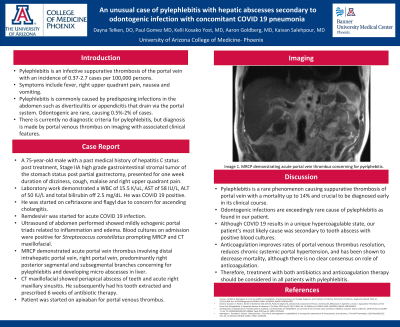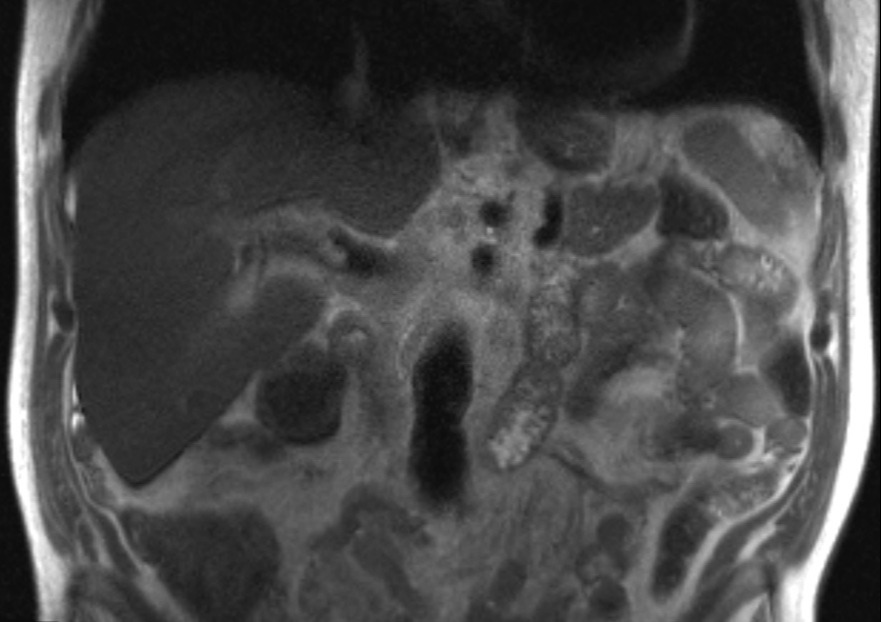Monday Poster Session
Category: Liver
P2498 - An Unusual Case of Pylephlebitis With Hepatic Abscesses Secondary to Odontogenic Infection With Concomitant COVID-19 Pneumonia
Monday, October 23, 2023
10:30 AM - 4:15 PM PT
Location: Exhibit Hall

Has Audio

Dayna M. Telken, DO
University of Arizona College of Medicine
Phoenix, AZ
Presenting Author(s)
Dayna M. Telken, DO1, Paul Gomez, MD1, Aaron Goldberg, MD2, Kaivan Salehpour, MD3, Kelli Kosako Yost, MD1
1University of Arizona College of Medicine, Phoenix, AZ; 2Carl T. Hayden Veterans Affairs Medical Center, Phoenix, AZ; 3Phoenix VA Health Care System, Pheonix, AZ
Introduction: Pylephlebitis is an infective suppurative thrombosis of the portal vein with an incidence of 0.37-2.7 cases per 100,000 person per year commonly caused by predisposing infections in the abdomen such as diverticulitis or appendicitis. Odontogenic infections are rare, causing 0.5% of cases. We present a case of a 75-year-old male who presented with cough, malaise and right upper quadrant abdominal pain for one week duration and was found to have pylephlebitis secondary to odontogenic infection.
Case Description/Methods: A 75-year-old male with a past medical history of hepatitis C status post treatment, stage IIA high grade gastrointestinal stromal tumor of the stomach status post partial gastrectomy, presented to the emergency department with one week of dizziness, cough, malaise, and right upper quadrant pain. He was found to be COVID-19 positive. Laboratory work significant for a white blood cell count of 15.5 K/uL with neutrophilic predominance, aspartate aminotransferase 58 U/L, alanine aminotransferase 50 U/L, total bilirubin 2.5 mg/dL. He was started on ceftriaxone, metronidazole and received remdesivir. Abdominal ultrasound showed mildly echogenic portal triads consistent with inflammation and edema. Blood cultures drawn on admission returned positive for Streptococcus constellatus, prompting additional imaging to localize a source of infection. Abdominal MRI demonstrated enhancement of portal vein with acute portal vein thrombus involving the distal intrahepatic portal vein, right portal vein, predominantly right posterior segmental and subsegmental branches with developing micro abscesses in the liver consistent with pylephlebitis. CT maxillofacial showed periapical abscess of teeth. He subsequently had his tooth extracted and was prescribed 6 weeks of antibiotic therapy. He was started on anticoagulation with heparin drip and ultimately transitioned to apixaban.
Discussion: Pylephlebitis is a rare phenomenon causing suppurative thrombosis of portal vein with a mortality up to 14%. The most common sources of infection are diverticulitis and appendicitis. Liver abscesses are a known complication of pylephlebitis. While Streptococcus bacteremia is one of the most common causes of pylephlebitis, odontogenic infections as the underlying etiology are exceedingly rare. Treatment involves antibiotics and possible anticoagulation on a case-by-case basis.

Disclosures:
Dayna M. Telken, DO1, Paul Gomez, MD1, Aaron Goldberg, MD2, Kaivan Salehpour, MD3, Kelli Kosako Yost, MD1. P2498 - An Unusual Case of Pylephlebitis With Hepatic Abscesses Secondary to Odontogenic Infection With Concomitant COVID-19 Pneumonia, ACG 2023 Annual Scientific Meeting Abstracts. Vancouver, BC, Canada: American College of Gastroenterology.
1University of Arizona College of Medicine, Phoenix, AZ; 2Carl T. Hayden Veterans Affairs Medical Center, Phoenix, AZ; 3Phoenix VA Health Care System, Pheonix, AZ
Introduction: Pylephlebitis is an infective suppurative thrombosis of the portal vein with an incidence of 0.37-2.7 cases per 100,000 person per year commonly caused by predisposing infections in the abdomen such as diverticulitis or appendicitis. Odontogenic infections are rare, causing 0.5% of cases. We present a case of a 75-year-old male who presented with cough, malaise and right upper quadrant abdominal pain for one week duration and was found to have pylephlebitis secondary to odontogenic infection.
Case Description/Methods: A 75-year-old male with a past medical history of hepatitis C status post treatment, stage IIA high grade gastrointestinal stromal tumor of the stomach status post partial gastrectomy, presented to the emergency department with one week of dizziness, cough, malaise, and right upper quadrant pain. He was found to be COVID-19 positive. Laboratory work significant for a white blood cell count of 15.5 K/uL with neutrophilic predominance, aspartate aminotransferase 58 U/L, alanine aminotransferase 50 U/L, total bilirubin 2.5 mg/dL. He was started on ceftriaxone, metronidazole and received remdesivir. Abdominal ultrasound showed mildly echogenic portal triads consistent with inflammation and edema. Blood cultures drawn on admission returned positive for Streptococcus constellatus, prompting additional imaging to localize a source of infection. Abdominal MRI demonstrated enhancement of portal vein with acute portal vein thrombus involving the distal intrahepatic portal vein, right portal vein, predominantly right posterior segmental and subsegmental branches with developing micro abscesses in the liver consistent with pylephlebitis. CT maxillofacial showed periapical abscess of teeth. He subsequently had his tooth extracted and was prescribed 6 weeks of antibiotic therapy. He was started on anticoagulation with heparin drip and ultimately transitioned to apixaban.
Discussion: Pylephlebitis is a rare phenomenon causing suppurative thrombosis of portal vein with a mortality up to 14%. The most common sources of infection are diverticulitis and appendicitis. Liver abscesses are a known complication of pylephlebitis. While Streptococcus bacteremia is one of the most common causes of pylephlebitis, odontogenic infections as the underlying etiology are exceedingly rare. Treatment involves antibiotics and possible anticoagulation on a case-by-case basis.

Figure: MRI abdomen demonstrating both enhancement of portal vein and portal venous thrombus consistent with pylephlebitis.
Disclosures:
Dayna Telken indicated no relevant financial relationships.
Paul Gomez indicated no relevant financial relationships.
Aaron Goldberg indicated no relevant financial relationships.
Kaivan Salehpour indicated no relevant financial relationships.
Kelli Kosako Yost indicated no relevant financial relationships.
Dayna M. Telken, DO1, Paul Gomez, MD1, Aaron Goldberg, MD2, Kaivan Salehpour, MD3, Kelli Kosako Yost, MD1. P2498 - An Unusual Case of Pylephlebitis With Hepatic Abscesses Secondary to Odontogenic Infection With Concomitant COVID-19 Pneumonia, ACG 2023 Annual Scientific Meeting Abstracts. Vancouver, BC, Canada: American College of Gastroenterology.
